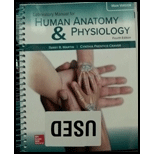
Laboratory Manual For Human Anatomy & Physiology
4th Edition
ISBN: 9781260159080
Author: Martin, Terry R., Prentice-craver, Cynthia
Publisher: Mcgraw-hill Education,
expand_more
expand_more
format_list_bulleted
Concept explainers
Textbook Question
Chapter 42, Problem 2.3CT
Predict what direction the oxygen dissociation curve will shift dining physical activity. Provide your reasons why.
Expert Solution & Answer
Want to see the full answer?
Check out a sample textbook solution
Students have asked these similar questions
The below graph shows both ventilation and blood lactate concentration as a function of total oxygen consumption during a bout of
exercise. Explain the relationship between these two variables and why these two measures (ventilatory threshold and lactate threshold)
tend to occur around the same level of exercise intensity.
Ventilation, L-min
170
150
130
110
90
70
50
30
10
• Ventilation
. Lactic Acid
0.5
Ventilatory threshold
gQ
Edit View Insert Format Tools Table
Anaerobic threshold
12
11
10
9
87
3
2
1
1.0 1.5 2.0 2.5 3.0 3.5 4.0 4.5
Oxygen Consumption, L-min
Lactic Acid, mM.L
The below graph shows both ventilation and blood lactate concentration as a function of total oxygen consumption during a bout of exercise. Explain the relationship between these two variables and why these two measures (ventilatory threshold and lactate threshold) tend to occur around the same level of exercise intensity.
What is a better or more efficient fuel; Carbohydrates or Fats?
What is the definition of RER or R values. And what is the R values at easy exercise and what is the R at high intensity exercise.
Chapter 42 Solutions
Laboratory Manual For Human Anatomy & Physiology
Ch. 42 - Prob. 1PLCh. 42 - Prob. 2PLCh. 42 - Prob. 3PLCh. 42 - Prob. 4PLCh. 42 - Coagulation should normally occur within a. 10...Ch. 42 - Prob. 6PLCh. 42 - A normal blood total cholesterol level is less...Ch. 42 - The high-density lipoproteins (HDLs) are sometimes...Ch. 42 - Prob. 1.1CTCh. 42 - Prob. 2.1A
Knowledge Booster
Learn more about
Need a deep-dive on the concept behind this application? Look no further. Learn more about this topic, biology and related others by exploring similar questions and additional content below.Similar questions
- What is the RER of an individual with an oxygen consumption of 220 ml/min and a carbon dioxide production of 182.6 ml/min? Report your answer to 2 decimal points. QUESTION 29 What percent of the individual's oxygen consumption in the previous question is being used to combust carbohydrate for energy? Round your answer to the nearest whole number and answer with a number only as units are given in the question.arrow_forwardReplenishing Fuel During Exercise Guidelines for replenishing fuel during exercise include Check All That Apply consume 30 to 60 grams of carbohydrate per hour. use only one type of carbohydrate to avoid gastrointestinal upset. use a fat supplement every 30 minutes. avoid fluid during exercise.arrow_forwardDuring maximal exercise RER will not rise above 1.0 due to the buffering of lactic acid which provides additional CO2 above that produced from the use of carbohydrates: Group of answer choices True Falsearrow_forward
- Based on the plot you’ve constructed:1. What relationship did you find between height and vital capacity?2. What might be the explanation for this relationship?3. How might these changes in size be explained?4. What factors may be contributing to the variation observedarrow_forwardOxidation of ingested CHO during exercise depends on each of the following variables except... Group of answer choices CHO flavor. ingested amount. exercise intensity. type of CHO.arrow_forwardAs the duration of a maximal effort increases from 10 seconds or less to between 10 and 180 seconds, what factor becomes limiting in terms of energy production?arrow_forward
- What is the main source during aerobic exercises? What is the benefit of aerobic respiration in the body? What is the benefit of anaerobic respiration in the body? How often does an individual should undergo aerobic and anaerobic exercises?arrow_forwardDiscuss why the body changes BP during exercise.arrow_forwardYour client has been exercising on a motorized treadmill, and you are interested in calculating oxygen consumption (VO2 in ml/kg/min), MET level, and energy expenditure (kcal/min). Session #1: Walking at 2.5 mph and 10% grade Calculate the following: Relative VO2 (mL/kg/min) METs Kcal/min Metabolic Calculations (ACSM Equations) Walking (1.9 to 3.7 mph) gross VO2 (ml · kg-1 · min-1) = [S × 0.1] + [S × G × 1.8] + 3.5 1 MET = 3.5 ml/kg/minarrow_forward
arrow_back_ios
SEE MORE QUESTIONS
arrow_forward_ios
Recommended textbooks for you
 Cardiopulmonary Anatomy & PhysiologyBiologyISBN:9781337794909Author:Des Jardins, Terry.Publisher:Cengage Learning,Lifetime Physical Fitness & WellnessHealth & NutritionISBN:9781337677509Author:HOEGERPublisher:Cengage
Cardiopulmonary Anatomy & PhysiologyBiologyISBN:9781337794909Author:Des Jardins, Terry.Publisher:Cengage Learning,Lifetime Physical Fitness & WellnessHealth & NutritionISBN:9781337677509Author:HOEGERPublisher:Cengage


Cardiopulmonary Anatomy & Physiology
Biology
ISBN:9781337794909
Author:Des Jardins, Terry.
Publisher:Cengage Learning,

Lifetime Physical Fitness & Wellness
Health & Nutrition
ISBN:9781337677509
Author:HOEGER
Publisher:Cengage
The Cell Membrane; Author: The Organic Chemistry Tutor;https://www.youtube.com/watch?v=AsffT7XIXbA;License: Standard youtube license